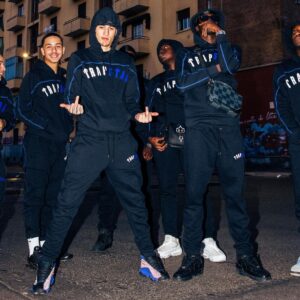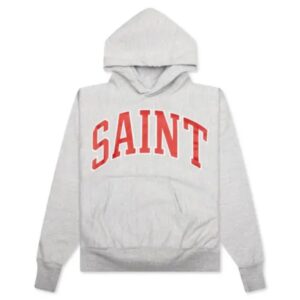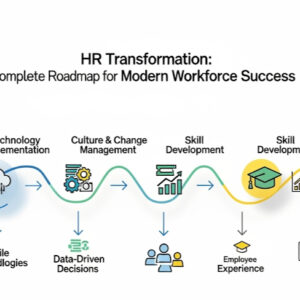Drop Dead:
Drop Dead was founded in 2005 by Oli Sykes, frontman of the British metalcore band Bring Me The Horizon. What began as a passion project quickly evolved into one of the UK’s most recognizable alternative fashion brands.Sykes, deeply entrenched in the hardcore and metal scenes, saw a void in the market—mainstream fashion brands weren’t catering to the raw, gritty, subversive aesthetic loved by fans of alternative music. So, he created his own. The brand began humbly with custom-designed T-shirts printed in Oli’s garage in Sheffield. These early designs, heavily influenced by horror films, punk rock, skate culture, and Japanese anime, stood out in a fashion landscape dominated by sterile, trend-chasing labels.
The Rise of a Cult Brand
Drop Dead Clothing was never meant to be “fashion” in the traditional sense. It was streetwear for misfits, built around themes of rebellion, nihilism, and emotional honesty. While most fashion houses chased prestige and elegance, Drop Dead chased authentic expression—an ethos that resonated with a generation disillusioned by the superficiality of mainstream culture.
In the mid-to-late 2000s, the emo and scene subcultures were booming. MySpace was in its prime. Tumblr was gaining traction. And Drop Dead’s raw aesthetic—featuring skeletons, monsters, neon blood splatters, and cryptic text—fit perfectly into this digital world. Their pieces weren’t just clothes; they were statements, worn by fans as badges of identity.
As Bring Me The Horizon’s popularity surged, so did Drop Dead’s. Fans saw Oli Sykes as both a music icon and a fashion visionary. With Sykes as the face and creative director, Drop Dead became synonymous with the underground fashion movement of the 2010s.
Aesthetic and Design Language
Drop Dead’s design language was unlike anything else on the market at the time. Imagine a melting pot of:
-
80s horror movie posters
-
90s cartoons like Ren & Stimpy
-
Anime like Akira and Neon Genesis Evangelion
-
Classic tattoo art
-
Anti-establishment punk iconography
Visually, Drop Dead combined grotesque with cute—often placing hyper-violent images next to pastel colors or wide-eyed creatures. This contrast became one of the brand’s signatures, pushing boundaries in both design and acceptability. Slogans like “Cute but Deadly” or “Rot in Hell” were printed on oversized hoodies and distressed T-shirts, directly appealing to a youth culture that embraced irony, emotional volatility, and outsider status.Each collection was carefully themed. For example, “Dead Cult” and “The Secret” collections focused on arcane symbols and esoteric mysticism, while “Ewok” drew inspiration from childhood nostalgia with a twisted edge.
Drop Dead’s Business Model and Limited Drops
Drop Dead helped pioneer the limited drop model long before it became the norm in streetwear culture. New collections would be teased on social media, dropped in small batches, and often sold out within hours.
This model achieved several things:
-
It kept the brand exclusive.
-
It built a sense of urgency and hype.
-
It prevented overproduction, aligning with growing sustainability concerns.
The label was also fiercely independent. For most of its early life, Drop Dead operated without major retail partnerships, relying instead on direct-to-consumer sales via its website and flagship stores in Sheffield and London. This allowed it to maintain full creative control and ensure every item stayed true to the brand’s vision.
Cultural Impact and Influence
Drop Dead was more than just clothing—it became a cultural symbol for alternative youth across the globe.
In the 2010s, teenagers and twenty-somethings who felt alienated from the glossy, consumerist fashion machine found a home in Drop Dead’s raw and emotive aesthetic. It wasn’t just about “looking cool.” Wearing Drop Dead was about expressing inner turmoil, embracing imperfection, and celebrating individuality.
The brand also opened doors for creative crossovers. It collaborated with video games (Sega’s Sonic the Hedgehog), cartoons (The Simpsons), and even with niche horror brands. These collabs cemented Drop Dead’s place as a bridge between pop culture and counterculture.
Challenges and Evolution
Like many niche fashion brands, Drop Dead faced its fair share of challenges. As the emo and scene subcultures began to decline in the mid-to-late 2010s, the brand had to adapt or risk fading into irrelevance.
Rather than abandon its roots, Drop Dead evolved. Its designs became more refined—still dark and weird, but more conceptual. The brand shifted from shock-value graphics to more minimalist, high-concept pieces while preserving the same emotional and aesthetic DNA.
Oli Sykes also used the brand to experiment with genderless fashion, eco-friendly materials, and ethical production methods. In doing so, Drop Dead began to appeal to a broader audience, while still catering to its core demographic of alternative creatives, musicians, and misfits.
Sustainability and Ethical Vision
In recent years, Drop Dead has made a strong push toward sustainable fashion, which aligns with growing consumer awareness about fast fashion’s environmental cost.
The brand began releasing lines using:
-
Organic and recycled cotton
-
Vegan-friendly dyes
-
Ethical labor practices
-
Recycled packaging
Drop Dead Today: A Living Legacy
Today, Drop Dead stands as one of the few fashion brands that has stayed true to its origins while successfully navigating two decades of evolving subcultures and trends.
Its influence is visible across today’s alternative streetwear scene—from newer labels that adopt its grotesque-meets-cute aesthetic, to established designers who borrow its maximalist visual storytelling. It’s no longer the trendy “emo brand” it once was—it’s a legacy brand, known for cultivating a powerful community and daring to be different.Drop Dead now offers everything from elevated outerwear and cut-and-sew pieces to accessories, skate decks, and art prints. It continues to attract both loyal fans and new generations of outsiders seeking a voice through fashion.
Conclusion:
Drop Dead Clothing represents more than a moment in youth culture. It’s a symbol of how fashion can empower individuality, challenge norms, and embrace emotional depth. What started as a DIY project by a musician with a vision has become a multifaceted global brand that still speaks to the heart of counterculture.





